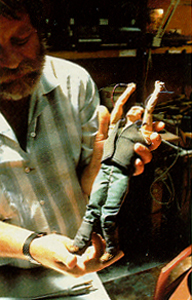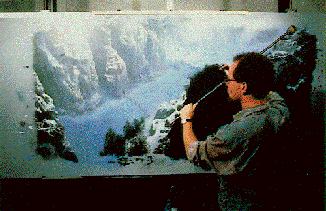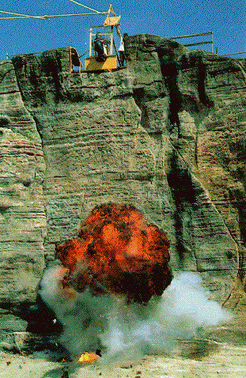SPECIAL EFFECTS // "CLIFFHANGER" (1993) |
No Visible Means Of Support |  |
|
Audiences going to the cinema to see a special effects film such as JURASSIC PARK know from the outset that the monsters are fake, the creation of artists and technicians. But there are many films for which special effects play a different, more subtle role: to help the audience believe that what they are seeing is actually "real," and to not draw attention to the artifice employed. For CLIFFHANGER, a drama set among the mountaintops of the Colorado Rockies, that meant Sylvester Stallone and his co-stars had to appear that they were actually hanging from ledges just inches from their deaths, thousands of feet above the ground, while being battered by snowstorms, explosions, and flocks of bats (enough to give a film company's insurers fits). To create such vertiginous illusions safely, a variety of special effects [including miniatures, paintings and computer-generated images] were interwoven with location footage to create a seamless mixture of live action and optically-enhanced photography. As the success of the film demonstrates, audiences respond to the film's drama perhaps without being aware of the illusions they are seeing. Boss Film Corporation, a pioneering special effects facility based in Marina del Rey, California, conjured up most of the visual trickery of CLIFFHANGER. Every shot of the film was storyboarded in advance, according to co-visual effects supervisor Neil Krepela, before principal photography commenced in the Italian Alps last year. The opening shot of the film is a prime example of how effects worked to make the characters appear to be in extremely hazardous situations. "We see Stallone hanging from a rope," says Krepela, "and as a helicopter drops into frame, the camera pulls back to reveal the full width of the scene — Stallone's character is a mere speck on a massive, high precipice. This was actually two separate pieces of film that had to be married in the computer." The shot was choreographed so that when the helicopter dips into view, the footage of the stunt double (shot in the Alps) takes over from a shot of Stallone (cozily filmed on the Cinecitta Studios backlot in Rome); the slow pull-back was orchestrated through a motion control system to make the cut invisible.
Front projection is another method for simulating a hazardous background. While an actor clings to a mockup of a cliff within a cozy stage set, 4 x 5 inch transparencies of Torre Divise, Pordoi or other peaks in the Dolomites illuminate a 15 x 20 foot screen behind him, making him appear a lot further away from the safety of an espresso bar. Zoran Perisic of Zoptic Special Effects [who helped make Superman fly] coordinated these shots. For wide-angle shots meant to convey great scope, detailed matte paintings can extend the scene beyond the small set pieces constructed on a stage. These vistas are painted on glass or foam boards with areas blacked out where the live action footage will appear. Moving clouds or snow added to the composite can give the image even greater depth. Miniatures were used for aircraft which crashed or exploded in mid-flight: these were highly intricate models [about one-sixth scale] which nonetheless had to withstand repeated smashing against a 50 foot-high mountainside erected in Boss's parking lot. Filmed at higher film speeds to make them appear more massive, the models were outfitted with explosives and maneuvered with cables or hidden armatures, and intercut with shots from Italy of full-size Hueys rigged to emit flames and smoke. A motorized Stallone puppet (also one-sixth scale) was dangled by a thin cable and set to kick and shake when a model helicopter exploded nearby. Apart from safety, another use of special effects is to correct flaws in the actual film. When a stuntman was to transfer in mid-air from a DC-9 to a smaller aircraft, the hazards and complications of setting up the shot [which was filmed over the Colorado Rockies] delayed the stunt until the mountains had passed out of view, revealing a barren desert underneath. Because the ground did not match the snow-covered mountains over which the scene was to take place, the background had to be removed and replaced with footage of mountains that did match.
In this case, special effects did not reduce the danger for the stuntman; they merely made the shot fit the rest of the film. It is an example of how the flexibility of computers assists filmmakers who want greater control over filming conditions as well as the final image. Computers can aid in cleaning up images, such as removing safety wires and other devices which protect actors but for the sake of the story should not be visible. The digital synthesis of film elements — that is, combining several foreground and background pieces on a computer to create one seamless shot — is also becoming more pervasive, and at Boss it has supplanted the use of optical printers traditionally used to marry pieces of celluloid together. "We have the best optical printers in the world, probably the best printing lenses you can get, a whole room full of them — and they're obsolete," said Krepela. "But we have a bigger room full of computers now, with 40 workstations. It's faster and a lot more flexible." One ironic aspect of CLIFFHANGER is that most of the people responsible for capturing the thrills and perils of mountain climbing had no prior experience in the sport. "I started out with no climbing experience," says Krepela, "and now I'm into rock climbing. I fell in love with it!" Given the visual terrors the filmmakers portrayed on screen, not many in the audience are likely to follow his example.
Postscript: In a development which points to the financial and competitive pressures facing the burgeoning computer graphics revolution, Boss Film Corporation closed its doors due to increasing overhead costs associated with having to keep up with the constant advances in CGI hardware technology. |
copyright 1993, 1997, 2009 by David Morgan
All rights reserved.







 One key shot in the film's prologue shows actress Michelle Joyner falling to her death. The filmmakers relied upon the bluescreen method, whereby a solid blue color is projected onto a screen behind the actors — in this case, a screen laid onto a floor at Cinecitta. Because a pure blue can be optically erased from celluloid, leaving a hole or "matte," a new background can be joined seamlessly (like puzzle pieces) with the foreground action, making it look as if Joyner had fallen thousands of feet into the chasm far below. The actress actually fell just 35 feet onto an oversized inflatable bag; this shot and the background plate were then digitally composited on a computer.
One key shot in the film's prologue shows actress Michelle Joyner falling to her death. The filmmakers relied upon the bluescreen method, whereby a solid blue color is projected onto a screen behind the actors — in this case, a screen laid onto a floor at Cinecitta. Because a pure blue can be optically erased from celluloid, leaving a hole or "matte," a new background can be joined seamlessly (like puzzle pieces) with the foreground action, making it look as if Joyner had fallen thousands of feet into the chasm far below. The actress actually fell just 35 feet onto an oversized inflatable bag; this shot and the background plate were then digitally composited on a computer.
 "First we did a computer-difference matte," said Krepela, "which did about 75% of the work of separating the jet, the stuntman and the rope from the background desert, and then basically it was all up to one person sitting there with a rotoscope computer program for weeks going over the shot frame by frame, doing a 'roto matte' to eliminate the scenery one pixel at a time." The new background — Vistavision footage of snow-covered mountains shot in Italy — also had to be optically altered so that the vanishing points in the two elements would match. "We surprised everybody. It's one of those shots that unless you talk about it nobody knows it's in the film; those are very pleasing."
"First we did a computer-difference matte," said Krepela, "which did about 75% of the work of separating the jet, the stuntman and the rope from the background desert, and then basically it was all up to one person sitting there with a rotoscope computer program for weeks going over the shot frame by frame, doing a 'roto matte' to eliminate the scenery one pixel at a time." The new background — Vistavision footage of snow-covered mountains shot in Italy — also had to be optically altered so that the vanishing points in the two elements would match. "We surprised everybody. It's one of those shots that unless you talk about it nobody knows it's in the film; those are very pleasing."